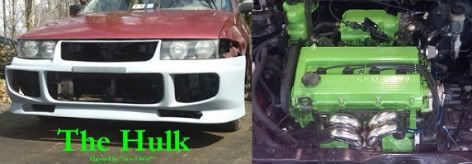Nothing like field trials to separate fact from crap. The laptop dyno runs in 3rd gear from low rpm to redline will reveal all. TQ moves up, moved out, or lowered throughout? Watch this space, once I get some of the rallycar prep that's staring me in the face done, I'll go do this experiment and report back!
Announcement
Collapse
No announcement yet.
Good exhaust theory essay
Collapse
X
-
'90 AWD Protege, full GTR drivetrain swap, ~320 whp daily driver, RIP, and
'90 AWD Protege, yet another GTR swap, Open class rallycar with a Toyota GT4 gearbox swap, thus crossing the line between hobby and mental illness. And a Brabus E55 K8, removing all doubt.
http://www.wihandyman.com/forum/vbpi...?do=view&g=110
http://www.cardomain.com/ride/2599486
-
Thanks a lot Jay, I have always enjoyed your insight, experience, and approach to solving problems.Originally posted by jay View PostNothing like field trials to separate fact from crap. The laptop dyno runs in 3rd gear from low rpm to redline will reveal all. TQ moves up, moved out, or lowered throughout? Watch this space, once I get some of the rallycar prep that's staring me in the face done, I'll go do this experiment and report back!
Comment
-
give it a go
 ---Has ClubProtege helped you in someway? show your support by Contributing--- Click Here---
---Has ClubProtege helped you in someway? show your support by Contributing--- Click Here---
1992- project FE3..... 313 WHP @ 9.3psi
I pet my dash when I get into the car..."good car"he actually has a mazda tree, parts grow on it

Comment
-
Looking forward to the resultsI live my life a quarter pounder at a time. And for those 500 calories or more, I'm free. I need FRIES! Two of them. The big ones. Oh, and I need them tonight. You're lucky the double shot of BBQ sauce didn't blow the seam on your nugget box. There she is, 2 pounds of pure beef. My dad ate it in 9.0 seconds flat. Check it out, it's like this. If I lose, winner takes my happy meal. But if I win, I take the burger and the toy. To some people, that's more important.
._________________________
|.....Overnight....................| ||
|.....Japan Parts.................| |'|";,___.
|_..._...____________======||_|_|...,]
"(@)'(@)""'''''''''''''"'''"**|(@)(@)*****"(@)
Oh and by the way that shot in your banner with Vin Diesel's car getting shot, thats a civic not an altezza.

Comment
-
hey its been a year any results? lol
'95 Ford Escort LX, GTX block .40 over, wiseco 9.1 pistons, gtr rods, gtx head, MS1, 550 inj. T3/T4 .57 Trim, DSM BOV, WALBRO 255 FP, civic half rad, MSP LSD, stage 3 kyclutch, ebay short shifter, mx-3 rear tie bar, AEM wideband....SHE IS ALIVE
'88 Mazda Gtx AWD B6T engine Ported head, VJ-11, EL prototype chipped ECU, Blitz SBC-iD electronic boost controller, Full HKS exhaust, Centerforce dual friction clutch & more
Comment
-
I was gonna do this last time we were at the dyno but problems came up and we ran outta time. I'll do my damndest to run this experiment when we bring the rallycar in for tune before next event, which is coming right up...march 7. I better get my rear in gear.
I will mention this in the meantime. Corksports' drag Protege, 450 whp or something like that, has an exhaust setup on it. It's a 15" long chunk of 4" pipe that exits out the front fender. Is it cuz they wanted to lower thier tq and hp numbers? No I ain't advocating open dump for street cars, but as close as you can get away with.Last edited by jay; 02-19-2009, 11:46 AM.'90 AWD Protege, full GTR drivetrain swap, ~320 whp daily driver, RIP, and
'90 AWD Protege, yet another GTR swap, Open class rallycar with a Toyota GT4 gearbox swap, thus crossing the line between hobby and mental illness. And a Brabus E55 K8, removing all doubt.
http://www.wihandyman.com/forum/vbpi...?do=view&g=110
http://www.cardomain.com/ride/2599486
Comment
-
I read an article by Corky Bell once about miata turbo downpipes.
The BEGI ones Corky does start of smaller at the outlet of the turbine and gradually get larger until full 3" is realized. You can buy 'swages' that go from 2.5 to 3 from summit. I might make the switch to a CS dp and use one of those cos it achieves similar results with less work and cost.
In the photo below I compare the CS dp to the BEGI miata one. The numbers in blue are the pipe size in inches. The really important numbers are the Areas marked in RED.
The begi you can see the pipe increases in size 3 times, while the CS is one approximate average of those sizes.
Comment
-
I just found this thread, and felt I needed to comment. The engineer is spot on, and knows what he is talking about. My work experience is in the fluid power engineering and design field, and we obviously deal with fluid dynamics all day long.
To create flow in any fluid (liquid or gas), you need a pressure differential. As long as the pressure upstream is higher than the pressure downstream, the fluid will flow. The higher pressure differential (also know as "delta pressure", or ∆P), the faster and more forcefull the fluid (gas in this case) will move. In an NA engine, the upstream pressure is created both by piston moving up towards TDC, thereby decreasing displacement (Boyle's Law) and increasing pressure, by thermal expansion (Ideal Gas Law). The exhaust valve opens before combustion expansion is complete, sharing some of that pressure with the upstream exhaust flow, which forces the gases towards the low pressure downstream area (tailpipe). The larger this pressure drop, the harder and faster the exhaust gases move towards the tail pipe. You can create a higher ∆P by either increasing pressure at the upstream area (which potentially wastes energy that could be used pushing down on the piston to create power) or decreasing pressure downstream (by having the lowest restriction in your exhaust possible, without sacrificing velocity).
As you can see, if you create backpressure in your NA exhaust system, your ∆P is less, and the force/velocity of your exhaust is less. Backpressures of 30 psi are easy, and it all depends on where in your exhaust you measure it. Thermal expansion of the hot gases creates pressure (Ideal Gas Law), but inversely lose pressure as the exhaust cools, which adds to that downstream low pressure ideal.
As it relates to a forced induction, a high pressure differential is obviously also ideal. The more pressure you have on the inlet side of the turbine and the less pressure you have on the outlet side of the turbine, means the turbine will spin harder and faster. Having zero (or a vacuum, like he said) backpressure is the best thing you can do with forced induction, because it creates a higher differential across turbine. If anyone knows anything about electricity, compare a turbo to an electric motor. Electrons only flow when there is "potential," which is a voltage drop. The higher the voltage drop across a motor, the "harder" it wants to spin. This is why high power motors are high voltage, because they require less amperes to do their work.
If anyone wants a better explanation about why pressure drop is ideal, I can gladly explain. However, I hope this helps.
Comment

Comment